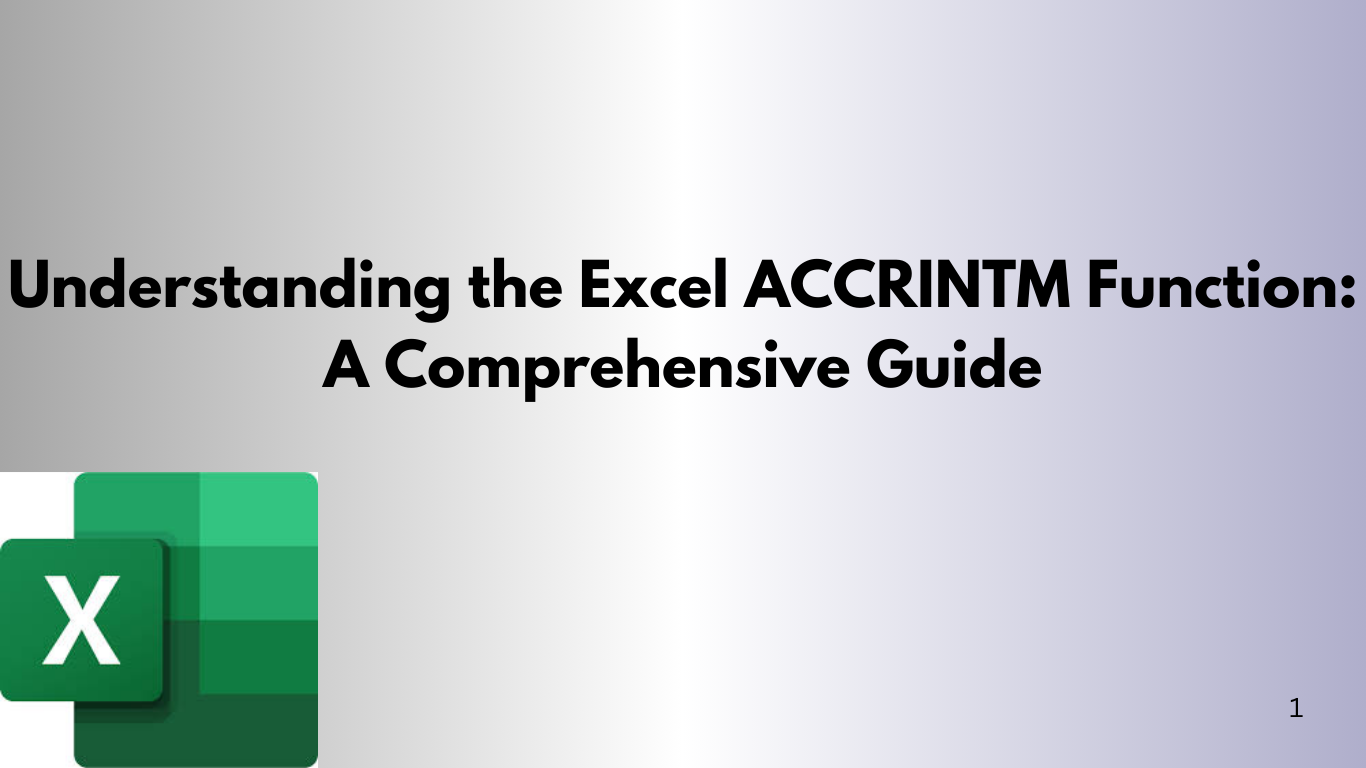In finance, knowing the interest on investments is key. Bonds need their interest calculated from issue to next coupon date. Excel's ACCRINTM function makes this easier, especially for bonds with a maturity date.
Now, let's explore how ACCRINTM works, see examples, and learn how to use it in VBA.
What is the ACCRINTM Function?
The ACCRINTM function in Excel finds the interest accrued on a bond. It's from the settlement date to the maturity date. This is useful for bonds or similar securities.
Syntax of ACCRINTM
ACCRINTM(settlement, maturity, investment, rate, par, frequency, basis)- Settlement: The bond’s settlement date. This is the date after issuance when the bond is traded to the buyer (must be entered as a date).
- Maturity: The bond’s maturity date. This is the date the bond expires and the principal is paid back (must be entered as a date).
- Investment: The amount of money invested in the bond or security.
- Rate: The bond’s annual coupon rate (expressed as a decimal).
- Par: The bond’s par value or face value (typically $1000).
- Frequency: The number of coupon payments per year. For annual payments, this is 1; for semiannual payments, it is 2; for quarterly payments, it is 4.
- Basis: The day count basis to use for the calculation. This determines how days in months and years are counted. It can be:
- 0 or omitted: US (NASD) 30/360
- 1: Actual/Actual
- 2: Actual/360
- 3: 360/360
- 4: European 30/360
Example 1: Basic Usage of ACCRINTM
Imagine investing $5,000 in a bond with these details:
- Settlement Date: January 1, 2025
- Maturity Date: January 1, 2027
- Investment: $5,000
- Coupon Rate: 6% (0.06)
- Par Value: $1,000
- Frequency: 2 (semiannual payments)
- Basis: 1 (Actual/Actual)
To find the accrued interest, use this Excel formula:
=ACCRINTM("2025-01-01", "2027-01-01", 5000, 0.06, 1000, 2, 1)Explanation:
- The settlement date is January 1, 2025.
- The maturity date is January 1, 2027.
- You are investing $5,000 with a coupon rate of 6%, and the bond pays interest semiannually.
- The face value of the bond is $1,000, and we’re using the "Actual/Actual" basis (Basis 1).
When you press Enter, Excel will return the value of accrued interest between these two dates.
Example 2: Adjusting for Different Settlement and Maturity Dates
Suppose you are now calculating for a different bond with:
- Settlement Date: February 15, 2025
- Maturity Date: August 15, 2027
- Investment: $10,000
- Coupon Rate: 5.5% (0.055)
- Par Value: $1,000
- Frequency: 1 (annual payments)
- Basis: 0 (30/360)
The formula in Excel would be:
=ACCRINTM("2025-02-15", "2027-08-15", 10000, 0.055, 1000, 1, 0)Expected Output:
The formula will return the accrued interest on the bond for the given period based on the 30/360 day count basis.
Using ACCRINTM in VBA: Automating the Calculation
Now let’s explore how to use ACCRINTM in a VBA scenario. Suppose you want to create a simple VBA function that calculates the accrued interest for multiple bonds based on varying settlement dates and other parameters.
VBA Code:
Function CalculateAccruedInterest(SettlementDate As Date, MaturityDate As Date, Investment As Double, _
Rate As Double, ParValue As Double, Frequency As Integer, Basis As Integer) As Double
' Use ACCRINTM function to calculate the accrued interest
CalculateAccruedInterest = Application.WorksheetFunction.AccrIntM(SettlementDate, MaturityDate, Investment, _
Rate, ParValue, Frequency, Basis)
End FunctionHow to Use the VBA Function:
- Press Alt + F11 to open the VBA editor.
- Click on Insert → Module to create a new module.
- Paste the above code into the module.
- Close the VBA editor.
Now, in any worksheet, you can use the function like a regular Excel function. For example:
=CalculateAccruedInterest("2025-02-15", "2027-08-15", 10000, 0.055, 1000, 1, 0)This custom VBA function allows for easy reuse and greater flexibility when working with multiple bond calculations.
Conclusion
The ACCRINTM function is key for bond work. It helps with interest calculations over time, even if payments are only at maturity. It's useful for simple or complex bond interest tasks, especially with VBA automation.
Learning ACCRINTM lets you accurately track accrued interest. You'll understand how different bond details affect your investment's interest.
